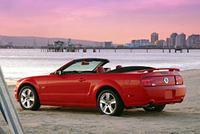Mustang Convertible is New and Improved
By: Kristopher Spencer | Ford Communications Network
Automotive journalists are saying that the 2005 Ford Mustang convertible is more than just a pretty chassis. Find out more about the Ford Mustang convertible at fordvehicles.com. DEARBORN, June 10, 2005 -- When automotive journalists gush about the 2005 Mustang Convertible, as well as the coupe, it's not just lip service for the hottest car on the market. Aside from the car's popular styling, the convertible boasts a variety of improvements in fit and finish and ride dynamics over previous incarnations.
"Wind noise was reduced by 12 to 15 percent versus the '04 convertible to a level comparable to the '04 coupe," said Keith Knudsen, Mustang Vehicle Engineering supervisor. Knudsen added that body air leakage, which contributes to cabin noise, also has been reduced by 25 percent versus the 2004 Mustang. Data to support these claims was collected in wind tunnel tests using high-tech microphones.
"As convertibles go, this should be an easy car to live with through all four seasons," wrote Michael Jordon in Automobile magazine. The automotive reporter pointed out the convertible's electrically powered roof, which stows in a z-fold for top-down driving, possesses special features to seal out both the weather and wind noise when the top is up. Autocar reporter Howard Walker added that few convertibles are as quiet as the new Mustang with the top up.
Reduction of wind noise can be attributed to several design elements such as short drop glass, whereby the door glass instantly lowers by a half inch when the door is opened and instantly resumes its fully closed position once the door is closed.
"This allows the door glass to penetrate the seal bulb rather than just laying up against it as with conventional frameless glass," Knudsen said. "It is not an industry first, but this application is the first on a car in the Mustang's price range."
In addition, a double sealing system along the top of the windshield header and side glass interfaces reduces wind noise. A solid cast magnesium top header panel with new refined latching system also prevents wind buffeting that would normally occur on stretched fabric. Plus, a floating five-bow top design enables every foam-insolated three-layer top to be "custom fit" to the body, ensuring less variability in fit and few compromises to the seal system.
"That kind of attention to detail translates into 'best-in-class' performance," said Tom Barnes, Mustang Vehicle Engineering manager. On the Global Quality Reporting System, the new coupe scored a mere 59 things gone wrong (TGW) on three months in service compared to 120 TGW for the Toyota Celica and 241 TGW for the Mitsubishi Eclipse. "Based on our internal testing, we expect the same type of best-in-class performance on the convertible," he added.
According to Barnes, early involvement between engineering and manufacturing ensured production feasibility for advances such as the car's sealing system. "The Flat Rock plant is monitoring air-leakage on a daily basis to ensure we keep the car tight," he added.
Knudsen added that keeping air, wind and water out, along with improved top-down appearance, required a minor tradeoff: a slightly slower open and close speed. "The '04 top folded in a more simple and conventional manner than the '05's state-of-the-art z-fold, thus it was a bit faster," he said. "But at 13 seconds the '05's cycle time is still much faster than more expensive competitors like the Corvette and Saab 900, at 20 seconds."
With the top down most convertibles lose torsional rigidity, which is simply a vehicle body's resistance to twisting forces. A common analogy for torsional rigidity is a shoebox. With the lid on, a shoebox is not easy to twist or bend. With the lid off (like an open convertible), the shoebox tends to lose its rigidity. By placing the lid on the bottom of the open shoebox it regains much of that rigidity. In a similar way, Mustang Convertible engineers added rigidity without extra weight by using stiffer underbody architecture. Even with the extra reinforcements, the Mustang Convertible is only 150 pounds heavier than the coupe -- compared to the average 300 pounds other convertibles add.
With the convertible buyer in mind, Mustang engineers also tuned the convertible's springs for a 14 percent to 15 percent softer ride than the coupe. In addition, the front struts and rear shocks also were tuned to provide a slightly more relaxed ride without trading off steering response.
"Convertible buyers look for a bit more relaxed ride than a coupe buyer," said Knudsen. "And because the convertible body is not quite as stiff as the coupe's, softened springs provide a better match between body and chassis response."
"For some vehicles, convertibles are designed after the coupe as an afterthought," said David Fee, Mustang marketing manager. "The engineering team designed the '05 Mustang simultaneously as a coupe and convertible right from the start."
As automotive reporter Brian Chee noted on Autobytel.com the Mustang convertible "is so close in performance and drivability to the coupe that one must really only choose on price and appearance. And that's not easy, given the competitive price."
Fee said Ford has historically sold about 30 percent of Mustang as convertible. But based upon the superior design of the 2005 Mustang Convertible, and the overwhelming praise it has received, sales may be even higher. As Anita Lienert stated in her review of the vehicle in The Detroit News, the Mustang is "destined to be convertible of the year."



